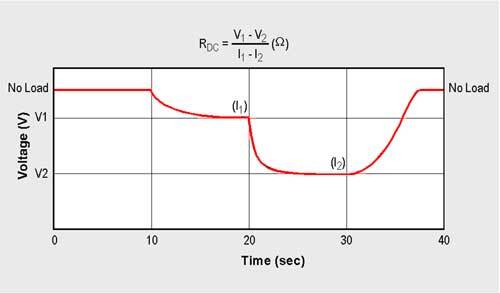When studying the characteristics relating to battery state-of-health (SoH) and state-of-charge (SoC), some interesting and disturbing effects can be observed - the properties are cumbersome and not linear. Worst of all, the parameters are unique for every battery type. This inherent complexity makes it difficult to create a formula for rapid testing that works for all batteries.
In spite of these seemingly insurmountable odds, battery rapid testing is possible. But the questions are asked, how accurate will the test results be and how will the system adapt to different battery types. Instrument cost and ease-of-use are also concerns. This paper evaluates currently used methods, which include the load test, AC conductance test and the six-point test developed by Cadex.
The load test
The load test provides important battery information consisting of open battery voltage, voltage under load and internal resistance. nickel-based batteries should always indicate an open terminal voltage of about 1.1V/cell, even if empty. The electro-chemical reaction of the different metals in the cell generates this voltage potential. A depressed voltage may indicate high self-discharge or a partial electrical short.
A lead-based battery must always have a charge and the open terminal voltage should read 2.0V/cell and higher. If below 2 volts, a sulfation layer builds up that makes a recharge difficult, if impossible. An open terminal voltage of 2.10V/cell indicates that the battery is roughly 50% charged.
The voltage of a lithium-based battery can, to some extent, indicate SoC. A fully charged cell reads about 4.0V/cell and a partially charged cell measures between 3.0 and 4.0V/cell. The load test applies a momentary load, during which the voltage is measured. Voltage over current equals the resistance. More accurate results are obtained by applying a two-stage load. Figure 1 illustrates the voltage pattern of such a two-stage load test.

The AC conductance test
An alternative method of measuring the internal battery resistance is the AC conductance test. An alternating current of 50 to 1000 Hertz is applied to the battery terminals. The battery's reactance causes a phase shift between voltage and current, which reveals the condition of the battery. AC conductance works best on single cells. Figure 2 demonstrates the relation of voltage and current on a battery.
 |
Figure 2: AC load test. The AC method measures the phase shift between voltage and current. The battery's reactance and/or voltage deflections are used to calculate the impedance.
Some AC resistance meters evaluate only the load factor and disregard the phase shift information. This technique behaves similar to the pulse method in that the AC voltage is superimposed on the battery's DC voltage and acts as brief charge and discharge pulses. The amplitude of the ripple is utilized to calculate the internal battery resistance.
There are some discrepancies in the resistance readings between the 'load test' and 'AC conductance test'. The differences are more apparent on marginal than on good batteries. So which reading is correct? In many aspects, the AC conductance is superior to the load test, however, one single frequency cannot provide enough data to evaluate the battery adequately. Multi-frequency devices are being developed but their complexity rises exponentially with the number of frequencies used.
Resistance measurement, as a whole, provides only a rough sketch of the battery's performance because various battery conditions affect the readings. For example, a battery that has just been charged shows a higher resistance reading than one that has rested for a few hours. An empty or nearly empty battery also exhibits elevated internal resistance. To obtain reliable readings, a battery must be at least 50% charged.
Temperature further affects the internal resistance readings. A hot battery reads a lower resistance than one at ambient temperature or one that is cold. In addition, the chemistry, the number of cells connected in series and the current rating (size in mAh) of a battery influence the results. Many batteries also contain a protection circuit that further distorts the readings.
The Cadex QuickTest™
Cadex Electronics has developed a method to measure the state-of-health (SoH) of a battery in 3 minutes. QuickTest™ uses a patent-pending inference algorithm to fuse data from 6 variables, which are: capacity, internal resistance, self-discharge, charge acceptance, discharge capabilities and mobility of electrolyte. The data is combined with a trend-learning algorithm to provide an accurate SoH reading in percent. Figure 3 illustrates general structure of such a network.
 | Figure 3: General structure of the Cadex QuickTest™ Multiple variables are fed to the micro controller, 'fuzzified' and processed through parallel logic. The information is averaged and weighted according to the battery application. |
QuickTest™ is built into the Cadex C7000-Series battery analyzers and services nickel, lithium and lead-based batteries for two-way radios, cell phones, laptops, scanners and medical devices. The analyzers are user-programmable and also perform battery priming, reconditioning, fast-charging, life-testing and boosting functions.
QuickTest™ uses battery specific matrices that are obtained with the analyzer's trend learning process. The ability to learn allows adapting to new batteries in the field. The matrices are stored in the battery adapters and automatically configure the analyzer to the correct battery setting. The adapters commonly include the matrix at time of purchase. If missing, the matrix can be added in the field by scanning two or more batteries on the analyzer's Learn program. The required charge level to perform QuickTest™ is 20-90%. If outside this range, the analyzer automatically applies a brief charge or discharge.
What is the definition of state-of-health and when should a battery be replaced? SoH reveals the overall battery conditions based on the above mentioned variables, which are capacity, internal resistance, self-discharge, charge acceptance, discharge capabilities and mobility of electrolyte. If any of these variables provide marginal readings, the end result will be affected. A battery may have a good capacity but the internal resistance is high. In this case, the end SoH reading will be lowered accordingly. Similar demerit points are added if the battery has high self-discharge or exhibits other chemical deficiencies. The battery should be replaced if the SoH falls below 80%.

Comments
Looking for comments from the previous website?
Comments from the previous website are not compatible with our new commenting system but we have preserved them so our users can still reference and make use the information in them.
